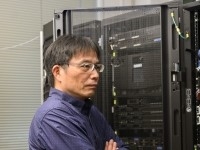Jun. 12, 2025
Mouse data librarian
Toyoyuki Takada’s day-to-day involves documenting genomic material selected from more than 9,000 strains of mice, including models of human diseases ranging from dementia to diabetes.
Toyoyuki Takada, Research & Development Scientist
In a sprawling facility near Tsukuba, Japan, research scientist Toyoyuki Takada spends his days among the unsung stars of biomedical research: mice. Not just any mice, but a veritable ark of more than 9,000 strains, some of which are having their genomes meticulously analysed and catalogued.
These are more than just the scurrying critters of basements and barns, but key research resources—models of human disease that help to reveal key aspects of ailments ranging from diabetes to Alzheimer’s. Takada, who works in the Integrated Bioresource Information Division at the RIKEN Bioresource Research Center (BRC), is a translator of this genomic library.
Takada’s roots lie in the study of the genomic intricacies of livestock—cattle, goats and other animals bred for food. From there, he earned a PhD in animal science and embarked on a postdoctoral journey that led him to projects cataloguing the mouse genome.
At the BRC, Takada and his collaborators now uses the latest genome sequencing technology to update MoG+—or MoGplus—a database that scientists use for genomic research and to obtain information to help engineer a mouse genome, be it to knock out a gene or insert one borrowed from another species.
MoG+ also operates a ‘mouse matching’ function in which a scientist studying genes related to Alzheimer’s disease, for instance, can search for mouse strains that mirror linked human genetic profiles.
The center represents a key repository for important genetically modified mice created through laborious gene-editing experiments. At least three Nobel laureates have deposited their mice strains here, ensuring that groundbreaking examples—models tied to discoveries such as programmed cell death and cellular degradation—remain available for future generations.
For his part, Takada also provides essential genomic variant information to the center staff who care for the mouse strains, which helps them to carefully breed new generations. He finds satisfaction in this work. Supporting research and obtaining and providing the genomic information essential for quality control and strain preservation are not always glamorous tasks, but they are vital. “It’s very gratifying,” he says, "to provide such services to the research community.”
Yet, like many scientists, Takada contemplates a world where artificial intelligence and robotics transform the field. AI, he believes, could revolutionize the curation and analysis of genetic data, while robots might take over the day-to-day care of the animals. These tools, however, rely on a bedrock of quality data—precisely the kind of information Takada provides.
For now, there’s a lot of excitement about how AI is going impact bioscience research. But for AI to be truly effective, it needs a foundation of high-quality data to begin with. "That’s one reason why it’s so crucial to to document and share complex genomic information publicly," says Takada.

Toyoyuki Takada and Takanori Amano, from the RIKEN BRC's Next Generation Human Disease Model Research Team use genome sequencing to update MoG+—a database that scientists use for research and to help engineer mouse genomes. © 2025 RIKEN
Rate this article

